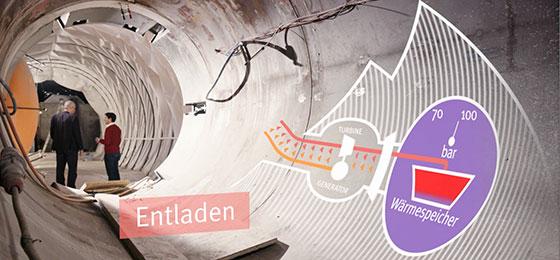Completed join project: Electricity storage via adiabatic air compression

Modern adiabatic compressed air storage power stations can achieve an efficiency ratio of 75% and represent an alternative to pumped-storage power plants.
Using simulations and experiments as well as a sustainability assessment, the NRP 70 joint project “Electricity storage via adiabatic air compression” investigated adiabatically compressed air storage power stations with the combined storage of sensible and latent heat in rock caverns.
Headed up by Prof. Aldo Steinfeld, the researchers at the Institute for Energy Technology of the ETH Zurich achieved the following results:
- The technical feasibility of AA-CAES was demonstrated through experiments with the world's first pilot plant. The plant used a combined sensible/latent TES and a rock cavern and attained estimated efficiencies of 63-74%.
- The combined TES was tested at temperatures of up to 566°C. The latent section reduced the drop in the outflow temperature during discharging.
- The degradation of the encapsulated phase-change material (PCM) was experimentally and numerically characterised and mitigation strategies based on a ceramic diffusion barrier were developed.
- A numerical model that simulates the dynamic behaviour of a complete AA-CAES plant was developed. The model includes realistic sub-models for the main plant components.
- AA-CAES and PHES have similar global warming and ecosystem quality scores. The economic performance of AA-CAES plants depends strongly on assumptions.
